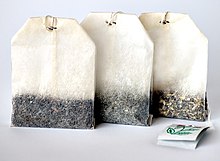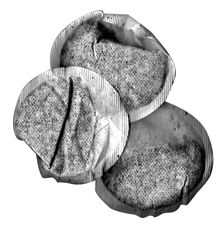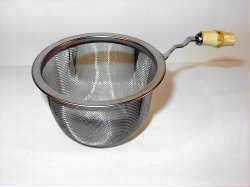
A tea strainer is a type of strainer that is placed over or in a teacup to catch loose tea leaves.

A drinking straw is a utensil that is intended to carry the contents of a beverage to one's mouth. Disposable straws are commonly made from plastics. However, environmental concerns related to plastic pollution and new regulation have led to rise in reusable and biodegradable straws. Following a rise in regulation and public concern, some companies have even voluntarily banned or reduced the number of plastic straws used. Alternative straws are often made of reusable materials like silicone or metal or alternative disposable and biodegradable materials like paper, cardboard, pasta, or bamboo.

PG Tips is a brand of tea in the United Kingdom manufactured by Lipton Teas and Infusions.

Barry's Tea is an Irish tea company founded in 1901 by James J. Barry in Cork. Until the 1960s, tea was sold from a shop in Prince's Street, but thereafter the company expanded its wholesaling and distribution operations. There is a common debate among Irish households about which is the superior Irish tea – Barry's Tea or Lyons Tea.

Plastic shopping bags, carrier bags, or plastic grocery bags are a type of plastic bag used as shopping bags and made from various kinds of plastic. In use by consumers worldwide since the 1960s, these bags are sometimes called single-use bags, referring to carrying items from a store to a home. However, it is rare for bags to be worn out after single use and in the past some retailers incentivised customers to reuse 'single use' bags by offering loyalty points to those doing so. Even after they are no longer used for shopping, reuse for storage or trash is common, and modern plastic shopping bags are increasingly recyclable or compostable. In recent decades, numerous countries have introduced legislation restricting the provision of plastic bags, in a bid to reduce littering and plastic pollution.
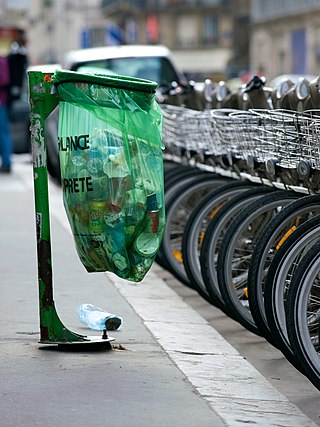
A bin bag, rubbish bag, garbage bag, bin liner, trash bag or refuse sack is a disposable bag used to contain solid waste. Such bags are useful to line the insides of waste containers to prevent the insides of the receptacle from becoming coated in waste material. Most bags today are made out of plastic, and are typically black, white, or green in color.

A coffee bag is a container for shipping and storing coffee. Coffee beans are usually transported in large jute sacks, while coffee sold to consumers may be packaged as beans or ground coffee in a small, sealed plastic bag.

A paper bag is a bag made of paper, usually kraft paper. Paper bags can be made either with virgin or recycled fibres to meet customers' demands. Paper bags are commonly used as shopping carrier bags and for packaging of some consumer goods. They carry a wide range of products from groceries, glass bottles, clothing, books, toiletries, electronics and various other goods and can also function as means of transport in day-to-day activities.
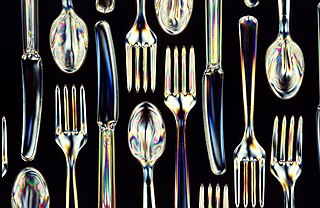
Bioplastics are plastic materials produced from renewable biomass sources, such as vegetable fats and oils, corn starch, straw, woodchips, sawdust, recycled food waste, etc. Some bioplastics are obtained by processing directly from natural biopolymers including polysaccharides and proteins, while others are chemically synthesised from sugar derivatives and lipids from either plants or animals, or biologically generated by fermentation of sugars or lipids. In contrast, common plastics, such as fossil-fuel plastics are derived from petroleum or natural gas.

Nonwoven fabric or non-woven fabric is a fabric-like material made from staple fibre (short) and long fibres, bonded together by chemical, mechanical, heat or solvent treatment. The term is used in the textile manufacturing industry to denote fabrics, such as felt, which are neither woven nor knitted. Some non-woven materials lack sufficient strength unless densified or reinforced by a backing. In recent years, non-wovens have become an alternative to polyurethane foam.

A cigarette filter, also known as a filter tip, is a component of a cigarette, along with cigarette paper, capsules and adhesives. Filters were introduced in the early 1950s.
Polyethylene or polythene film biodegrades naturally, albeit over a long period of time. Methods are available to make it more degradable under certain conditions of sunlight, moisture, oxygen, and composting and enhancement of biodegradation by reducing the hydrophobic polymer and increasing hydrophilic properties.

Biodegradable plastics are plastics that can be decomposed by the action of living organisms, usually microbes, into water, carbon dioxide, and biomass. Biodegradable plastics are commonly produced with renewable raw materials, micro-organisms, petrochemicals, or combinations of all three.

A single-serve coffee container is a container filled with coffee grounds, used in coffee brewing to prepare only enough coffee for a single portion. They come in various formats and materials, often either as hard and soft pods or pads made of filter paper, or hard aluminium and plastic capsules.
Oxo-degradation is a process of plastic degradation utilizing oxidation to reduce the molecular weight of plastic, rendering the material accessible to bacterial and fungal decomposition. To change the Molecular structure in order to break down under sunlight, the plastic can be broken down and eaten by micro-organisms. Oxo-degradable plastics- composed of polymers such as polyethylene (PE) or polypropylene (PP) -contain a prodegradant catalyst, typically a salt of manganese or iron.

Cellulose fibers are fibers made with ethers or esters of cellulose, which can be obtained from the bark, wood or leaves of plants, or from other plant-based material. In addition to cellulose, the fibers may also contain hemicellulose and lignin, with different percentages of these components altering the mechanical properties of the fibers.
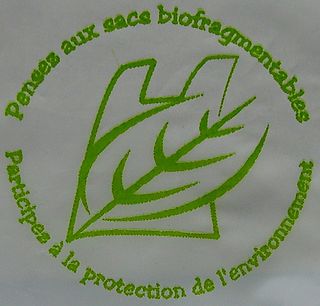
Biodegradable bags are bags that are capable of being decomposed by bacteria or other living organisms.

Numi Organic Tea is a privately owned triple bottom line social enterprise based in Oakland, California. Numi is known for its assortment of organic and fair trade certified teas and herbal "teasans". The company was founded in 1999 by brother and sister, Ahmed Rahim and Reem Hassani. The founders named the company "Numi" after the citrusy, Middle Eastern dried lime tea they drank as children growing up in Iraq. The name Numi is derived from the Arabic word for citrus. The J.M. Smucker Company holds a minority stake in Numi.
Plastic-coated paper is a coated or laminated composite material made of paper or paperboard with a plastic layer or treatment on a surface. This type of coated paper is most used in the food and drink packaging industry.
Mubarak Ahmad Khan is a Bangladeshi scientist who has been doing research into jute's commercial uses and possibilities. According to the science-based research database, Scopus, he is considered to be the leading scientist in the study of jute worldwide. He is currently serving as the Scientific Advisor of Bangladesh Jute Mills corporation (BJMC). Among his inventions are the Sonali Bag, Jutin, and helmets and tiles made from jute.


